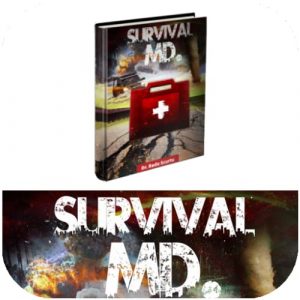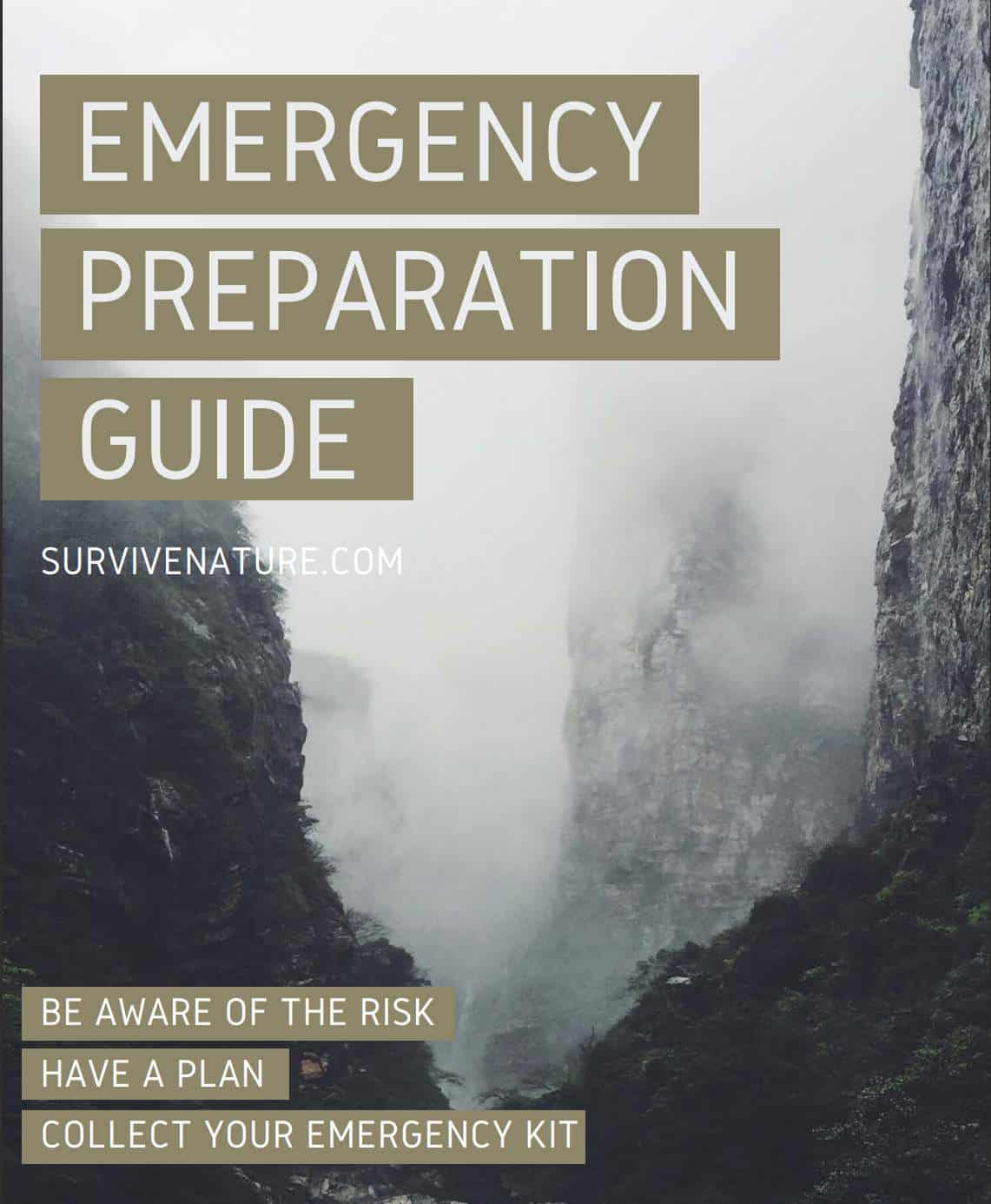The emergent situation can happen at any moment of your life. Whether it is a natural disaster that left you without shelter, electricity, and common food, or you just lost somewhere in the trees with wild animals while walking around the natural environment near your office. In any case, you need to know how to act in an unexpected survival situation.
Whatever happens, your survival skills and preparedness to face danger and survive are a must-have set of abilities. Your basic knowledge and your survival skills are your tools to make the way out of any danger. You should know how to give basic first aid, treat dehydration, cook food when there is no cooker and kettle nearby, be ready for fishing to survive, know how to avoid heat and cold, etc. Read about the crucial survival skills to raise your awareness about the knowledge you need to survive.
The wild game comes unexpectedly and the majority of people in survival situations die just because of inability to perform basic skills or because of debilitating effects such as stress and hopelessness. However, whether you are a new preppy or a veteran in the survivalists’ community, our concise guide on 7 basic survival skills and habits could lend you a hand in the wilderness or an emergency.
Thinking of basic survival skills and survival procedures, what comes to your mind first?
We will give you a hint: we consider crucial those basic survival skills that relate to endurance, keep you safe and sound, and lead to the quickest rescue possible. Below, we will walk you through the basic survival techniques that can save your life in any survival situation: you will learn how to face the wilderness survival, what your first aid kit should have to ensure the best first aid, how long we can cope without water and ways to purify water, too. Read on to learn more!
1. Starting a Fire With No Special Tools
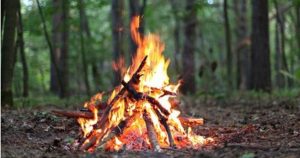
Do not underestimate this basic element even if you are lost somewhere in the Chihuahuan Desert heat or strolling through the Australian outback on a summer day. Bear in mind that the temperatures may range drastically in the area through the day and night. Especially in such places as deserts, since the ground there heats as fast as it cools. Therefore, the temperatures at night will show you all the difference. The main problem to consider here is the availability of tools for making the bonfire.
Fire provides us with at least three crucial aspects of survival, which any newbie is aware of:
- Heat – increases inner temperature by body heat, can dry wet clothes, and heat food to make it appropriate for eating;
- Smoke – to attract the attention of the rescuers, deterrence for wild animals;
- Light – also a strong sign for the rescuers, gives you an opportunity to see the surroundings even in the darkness.
Eventually, it turns out that fire is helpful in all survival scenarios and may even save your life in an emergency. A common phenomenon called hypothermia often takes place when the body temperature falls lower than 95Fº (35Cº), not to mention that the soaked clothing may aggravate the survival situation. Still, if the idea of dying of hypothermia does not make you tremble, think about the parasites invading under your skin.
Fire is not only a major heat source, but it is also a powerful tool to kill each one of those small critters and purify the raw meat from bacteria, not only does it warm our bodies and dries the moist clothes. So, mind your body heat and kill the parasites—all at once! Moreover, if you succeeded with a small fire, you can also dry wood to store it for a further situation or to expand the initial bonfire. A very big and hot fire can even boil water for you which is an essential feature for drinking untreated water from the river or any other questionable water.
Besides, do not forget about the signal light at night and how the smoky fire may help you install a massive signal light distinguished from a long way off. While the smoke from a fire is a good helper during the day, the light from a fire enlightens the darkness so that the wild animals stay away.
Moreover, if you are caught hungry in the wilderness, craving for a piece of smoked barbecue, here you are: smoke from your fire can be a perfect tool to smoke raw meat, a way of natural food preservation applied even by our distant ancestors. Smoke can equally prevent you from mosquito invasion, which is undoubtedly one of the worst things to happen outdoors. So, the fire will help you to remain calm in the majority of cases. That is why you should not underestimate the significance of fire-building skills.
Starting a fire depends mostly on your actions and the right equipment, not only on the weather; so, it can be easy as pie or hard as a rock. To ensure your preparedness, you need to have at least some of the fire-starting utensils, such as survival matches, survival lighters, and so on. Smokers are the most successful people in this situation since they almost always have a lighter with them (however, they should consider quitting smoking to prolong the fire activity and health abilities).
You may also think of wearing FireLaces which are 550 paracord bootlaces that include Ferro rods, before you are going to the forest adventure, as well. Here is a life hack straightaway: simple cotton balls and vaseline could serve as a quick and reliable fire starter. You can also find out how to ignite a fire with a bow drill kit fire starter, although this method is rarely used by those who got into a survival situation unexpectedly.
If you have got some materials to work with, try seeking cotton, petroleum jelly, a heat source, and a tin or a waterproof dry container. From these materials, you can make a fire starter to use in a further survival process with no matches or lighter. Melt jelly in a tin or container, cover the cotton balls with it, and set them aside to let them solidify. Store the balls in a dry place in order not to harm them accidentally.
Now let’s imagine what happens if you find yourself in the wilderness completely unprepared, with no survival gear at all. Sh*t happens, we see, but it is too soon to panic if you are aware of our natural fire starting techniques, so we kindly advise you to master it in advance.
2. Seeking, Finding, and Purifying Water

In order to be confident about your life chances, remember a simple rule of Threes. A human body can live without air for three minutes, three hours without a regulated body temperature, three days without water, and three weeks without food. As it follows, the water is the second priority after finding at least a temporary shelter. Undoubtedly, it will be hard for anyone to travel through the desert or a forest without water for a long time.
Seeking, Finding and Purifying Water is the foremost point in all unpredicted scenarios and dangerous situations. A certain amount of water is absorbed gradually but lasts continuously, providing the recovery of all forces through sufficient hydration. In case one has forgotten, the human body consists of water up to 60% of, and that is why all our organs require a permanent water intake. However, it is not the only option of water:
- Water is the primary component of our blood. Oxygen and useful nutrients are transferred from our lungs and digestive tract to the body cells with water.
- Water preserves and saturates our muscle tissue, ligaments, and joints. It lets us move effortlessly. Consider any metal-made mechanism. Without oil greasing, it becomes rusty and fails to work. The same skills belong to water in human bodies.
- Water supplies neurons and synapses in our brain, allowing them to operate properly.
- The diluted electrolytes solution is responsible for electric impulses, which provide the pumping actions for our heart — and water plays a key role in this electric cocktail.
The dehydration phenomenon can be explained as a critical decrease in the amount of water supply that the human body is designed to carry as one of the essential elements in its organs and tissues. One of the common symptoms of water loss or thirst is the mouth’s dryness, as this organ is connected to water saturation. Without the proper amount of saliva, its tissues cannot function normally. So the first sign of imbalanced hydration is this dry feeling in the mouth, which is the human condition commonly called thirst. If you are too busy to pay attention to this first sign, our body warns us of the second symptom: a mild and continuous headache. Over time it may get worse and be matched by further symptoms, such as: higher than average body temperatures, the violation of perspiration and tearing, nausea, increased heart rate, heat exhaustion, urinary output problems, the sense of prickling in the skin—up to lethargy and even death.
Thus, drinking a required amount of water is important not only in a survival situation but in daily life too. However, as in stressful conditions, dehydration occurs faster than in daily life. That is why it is one of your primary steps to find, purify, filter, and drink water regularly when in wilderness survival situations.
One of the approaches to collect and distill water is to use a solar still. You can easily make it if you have some materials found in the majority of the backyards. It is a tube, shovel (or you can use other tools for digging), container for pure water, a 5×5 feet piece of clear plastic, and a small rock. All you need is to find an open sunny space, dig a 3×3 feet hole, and place the container there. Cover it with a piece of plastic, and spread some dirt or wet sand around the edges, and place a rock upon it, so that there will be a 45-degrees angle. That is it! The distilled water will accumulate on the surface of the plastic and be stored in a container.
It’s a matter of time to master this essential survival know-how and get yourself the proper survival water filtration tools.
Sawyer Mini Water Filter
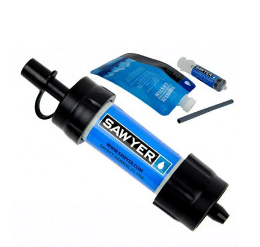
Our team recommends the Sawyer Mini Filter small in size, and it can provide up to 100,000 gallons of water through a 0.1-micron filter. Its compact design and advanced filtration system support a huge variety of retrieving water methods: plus, The Sawyer Mini has hose adapters on either side. Thus, you can easily purify water, convert Sawyer to a gravity filter, or screw onto a tiny bladder or an ordinary bottle to let you filter and drink on the move. Add its small weight of only 2oz, the length of 4″ g, and keep calm each time you go off the beaten track. For this filter’s price, it’s both your little travel companion and survival kit — an optimal solution for a survival situation.
Sawyer Mini Water Filters bears Sawyer’s registered trademark, all rights reserved.
3. Building A Survival Shelter From Scratch

Let’s pretend we have saved enough water and managed to start a fire, but the backup won’t be soon, and the night is going to be rough. In cold weather, you probably will not pull through without a survival shelter. A simple temporary shelter is not much, but a good survival shelter is totally different, with its protective capacities applicable in any disaster. No one is designed to be exposed to such hostile conditions, as freezing temperatures, heavy showers, torrid heat, high winds, massive snow, and so on, for a long while.
We have already explained the warning signals and the consequences of hypothermia and dehydration. Now let us consider the key features of an optimal survival shelter. We even have humidity level controllers in our apartments equally contributes to the importance of living conditions for such a subtle essence as a human being.
Basic Types Of Shelters
It was already mentioned, that shelter is the first-priority need in a survival situation. Nevertheless, the majority of people in distress are not capable of solving this problem due to the direct exposure of the natural elements. Therefore, the shelter should provide you with all the features that can protect you from nature and most importantly, temperature changes.
Anyways, being in the natural environment requires a special approach to lodging construction. It goes without saying that when choosing a type of shelter to build, it is crucial to take into account the following conditions:
- type of terrain, types of soil
- climate
- temperature and weather conditions (including humidity, the temperature difference, wind, and much more)
- closeness to drinking water and other water sources
- risk of natural disasters in the area
- the need to perform self-defense
- the number of people to stay there
- estimated length of stay, etc.
Among the most common and widespread types of shelter, there is a debris hut, personal or group shelter, a spider-type shelter, a sleeping-bag type of shelter, a lean-to shelter, a snow shelter, and so on.
When in an extreme environment, remember that your wilderness survival clock is ticking; that means our organism’s resistance to dehydration expires later than it does in severe weather conditions— in this case, it is a matter of hours or even less. First of all, try to learn more about the areas where you travel and check the materials’ availability in advance.
Whether it is a debris hut, a group shelter, a spider-type shelter, a lean-to shelter, or a snow shelter, it is strongly recommended to start building it before you are exhausted, take it as basic knowledge. A few hours are generally enough to make yourself a snow trench or a soil hut.
Moreover, most of the basic items and materials for your shelter can be easily found right in your backyard, so you do not have to spend half of your savings. If you are stuck in the forest, take a closer look at dead branches. Maybe it is the easiest-found and basic material to make a temporary shelter of. Try using a kind of forked stick as a base of the hovel, and by tying knots connect other branches to it. The wood is desirably to be dry, otherwise, such a shelter will not provide you protection against temperature drops at night.
In some cases, it is possible to use sleeping bags, build a shelter in the cave (beware of a mountain lion), or even to sleep in the ground! Although it sounds savage, it is a good method in survival situations. Find a sheltered place, place the rocks and dry tinder so that they form a cradle. Dig a little hole, lay the plants, moss, leaves, or other soft materials on the bottom of the hole and on its edges. Or make a debris hut using the trash found around. Be careful with having a fire heated the sleeping place! Use any fabric to cover you, the heat exchange will make its duty to keep you warm through the night. You can also store food in the same condition.
Needless to say, though, this shelter-building skill is recommended to practice in advance. Try implying it as one of the outdoor activities if you know your area is subject to natural disasters.
The TACT Bivvy Emergency Shelter

Take the knowledge of building survival shelters seriously, and in plus, consider purchasing TACT Bivvy. The Tact Bivvy is more than a sleeping bag; it may look like at first glance; it is a quality portable personal or group shelter and a basic first aid kit. Being made out of mylar and weighing almost nothing, it is based on a proven heat-trapping technology so that you always feel warm, whatever the conditions.
Among the many sorts of survival shelters, this little emergency sleeping bag could play a big role in your survival situation experience. This is just the case when two are better than one, so make sure you at least got one item in your bug-out bag and one in your get-home bag.
4. Mastering Survival Signaling To Help Rescue Team Find You

Generally, the rescue is highly desirable when in the wilderness survival situations unless you have willingly preferred Robinson’s way of life till its very end. Therefore, signaling is the best way of drawing attention and getting rescued as soon as possible.
However, its effectiveness is doubted unless you get acquainted with the fundamental principles for effective signaling: 1) Visual contrast with the environment and 2) Intelligence of a method. While the first seems obvious, the second means that your signal should drastically differ from a natural one so that a potential rescuer should not mistake it for any natural anomaly. A trace of human intelligence should be clearly read in it.
Though it may sound puzzling, in fact, there are a lot of means to achieve this. Instead of yelling and waving your hands helplessly, consider a fire created in the night, an emergency signal flare (remember fireworks on Titanic?), and other simple but efficient methods. One more signaling case is a ground-to-air: create a cross or an “SOS” lettering on the ground with branches, rocks, or anything else. The main point is that the material will be visible from helicopter flight altitude. As for the sound signals, think of using a whistle.
5. Mastering the Basic Survival Medical Skills
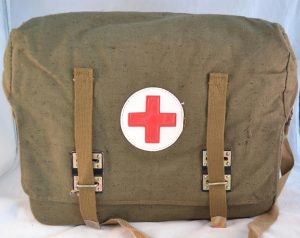
Sometimes in the wilderness, trouble comes double, and the survival situation worsens when you are injured. No matter what part of your body, be it a sprained ankle or a severe wound, the cost may be too high if you don’t know how to deal with such emergencies.
Do you still have no idea how to turn a piece of paracord into a stretcher or use a belt as a makeshift bandage? Well, here we supply you with the basic knowledge on how to make a first aid survival kit from some handy materials.
- If you have a laceration or other kind of wound, you should suture it in the nearest 24 hours in order not to have putrefaction. Do not use usual needles and knits since they may take harmful bacteria into the blood. Better use sutures, safety pins, or fishhooks. You must sterilize the materials with alcohol or boiled clean water, and start sewing the wound up from its center with separate stitches.
- In the case of injured limbs (broken, wounded, or dislocated arm, for instance), you will have to make a tourniquet to rather fix the position or stop the bleeding. Fortunately, you will need only two elements to do it: a piece of fabric (a thick tape, belt, etc.) and a branch. Wrap a tape around the higher part of the limb. Insert a branch into the node, and twist it several times, so that the blood will not have a chance to pour away. Fix the other end of a branch by tape on a lower part of the limb.
- Do not hurry to use any medicinal plants or green vegetation and do not even try eating unfamiliar berries and mushrooms! So many people even in not survival situations die from intoxication during hiking. So, you can eat only what you are 100% sure is harmless and you have eaten it before. Nevertheless, there exist some plants that are found helpful in a medical environment. Also do not forget to use clean water for washing food before eating.
It is no exaggeration to say this knowledge and skills are vital, so we offer you to start with the following handbook.
The Survival MD Training Guidebook
It’s the only complete medical survival guide for untrained ones; its foremost advantageous side is a step-by-step program approach that does not require preparatory training. You won’t need to spend a bucket load of cash or most of your leisure time to master the terms and instructions, as it is an absolutely comprehensive and accessible handbook — your personal first aid kit in the wilderness.
You will be surprised at what a difference it makes to finally master the art of gathering, honing, and applying your medical skills and further protecting your family from even the worst medical emergencies with our concise field guide.
6. Food Acquisition To Prevent Starvation
Most of the wilderness survival scenarios imply immediate rescue, finding water, and making a shelter – the most important benchmarks that are worth the efforts. Since we logically concluded that they are of more importance than food acquisition, we left it for the second half of our guide. However, providing a consistent amount of food supplies enough to endure as much as possible is a long-term goal equally important in the outlook. Though not being at the very top of a basic survival skills hierarchy, it is essential for future scenarios, especially the one when a pandemic has forced you away from your fellow humans and their contaminated cities, and you are planning to spend a long time in the deserted outdoors.
Purely and, how would you cope with building a shelter, seeking water, making a bonfire, and so on, when your organism is under direct exposure to a lack of vital forces? Once again, the need for food stuff and nourishment is not to be overlooked.
To have a consistent notion of the food supply needed, you must first understand what sorts of nutrients your organism craves. Let us remind you that these primary nutrients are presented by carbohydrates, fats, proteins, fiber, vitamins, and minerals, and all of them are downright necessary to pull through and outlast. Carbs and fats are responsible for necessary energy, while protein is accountable for building and repairing muscle tissue. A particular level of fiber is also necessary to maintain your digestive system and even live longer. Vitamins and minerals are crucial elements for our organism to function properly, not to mention their impact on the immune system. There is no need to mention the necessity to supply yourself with water again!
Our immune system is commonly compared to a bulletproof jacket: while the layer is sufficient, it simply pushes away diseases and infections as if they were bullets. Obviously, getting a sufficient amount of nutrients in nature is a totally different thing than buying them in a supermarket, and it will take time to find and cook them right. However, does a survivalist have many choices?
More than any other skill, you will need the ability to distinguish what you can eat and what you definitely must not try. Nevertheless, among the products accessible in the wild site, many may serve as food sources, to name just a few: fish, edible plants (there are a lot of them among wild plants), berries, mushrooms, fungi, and even pine trees. The average man needs no more than 2500 calories a day to maintain his weight, whereas the typical female has around 2000 calories. Nonetheless, these statistics are based on a nominal level of activity and therefore are very prearranged and dependent on the individual parameters.
Usually, when in survival mode, you are:
- building shelters
- moving long distances over roadless terrain
- carrying heavy gear and other basic items
- gathering edible plants and other food
- going small-game hunting
- seeking and boiling water and making fire
- exploring additional resources, new territories, or outer help.
After you went through this information, it must be evident that your organism will be burning on average a thousand more calories (!).
If the above-mentioned statistics seems not convincing enough, here are some additional data:
- The wild game contains about 500 calories per pound.
- Fish and seafood comprise 600-800 calories per pound.
- Green plants fall behind, containing about 100 calories or less per pound.

If the rescue is not the actual goal, but surviving in the wilderness is, this intensive calorie burn process will make food acquisition and preparation a ceaseless struggle, equal to the permanent urge to find, purify, and store water.
Happily, many handy even non-survival tools can help you in haunting food. A dull blade can be easily sharpened by a fine-grained rock and used in butchering wild game (and in self-defense too). Previously received potable water with fire make a great cooker. If you have a spine and hand drill, use it to gain sap and water from trees. By applying any cutting tool, a bottle of water, and a cord will give you a self-constructed trap for fish. Moreover, you can employ a needle and a fishing line to make a fishing rod!
You will have to come to terms with the fact that now you are a “calorie addict.” Constantly seeking calories may be compared with seeking pokemon by some teenage game addict – in other words, it will be your new full-time job in wilderness survival conditions. The only difference is that you are now the boss of your own life, as well as the employee, and the only one you depend on is your body and its strengths and resources.
7. Planning And Navigating Your Way Back To Safety
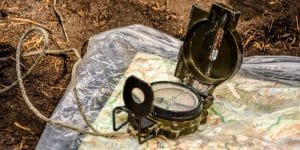
Almost everything in any survival scenario starts with the scene of a person losing their bearings in hostile surroundings. It could be named a four-letter-word LOST. The same-named TV series instantly comes to mind (do you remember the ending, by the way?). However, the real stories about wilderness survival usually end up not like this!
Is there any place left for the good news? Surprisingly, yes. Whether you are lost in the desert, dense forest, deserted tropical island, snow-covered mountains, the condition of being lost is…correctable and improvable, though not immediately. This is what the motivation couches call “take the courage and find your way.” The only difference is that you learn these “ways” and train them outdoors, in the wilderness, and not in the office or a gym.
The critical thing a disappointed one should bear in mind is: Lost is not the best thing to happen, but it’s not hopeless. Not at all. There are usually multiple means to find the right course out of wilderness survival. These ways and means are only hidden and yet to be discovered.
Firstly, you learn and gain some survival skills, then you obtain the same amount of mistakes from the experience. After all, you come out as the one able to do everything! As it was already mentioned, no other skill is as important as finding food, starting a fire, and filtering untreated water. So, you know what to start with.
Now it’s just the time to remember all your role models, heroes, adventurers, supermen, and wonder women from the movies and figure out the possible ways to get you back on the beaten track as soon as possible.
Navigation is quite an underrated and insufficiently practiced skill, though.
How To Master These Basic Survival Skills

Apart from two Basic Survival Techniques, there are two things you need to do to accomplish any skill.
- Learn from the theory
- Practice skills on your own experience
If you manage to master both of them consequently and steadily, then you will eventually master them. People usually say, “It’s not a matter of if, but when,” though this “when” is constantly postponed. In addition, this advice is applicable not only to survival skills but to everything you are getting on with.
We may safely say that theory and practice are fundamentally inseparable, and one should not run counter to another. In case you learn but don’t have time or wish to practice, you may call yourself bookish though skills dumb. You might be able to teach others how to survive, but you have most of the chances to fail disastrously when put to the real test.
Pretend the opposite thing happens: you practice enough but don’t learn the theory beforehand, then you’re only fooling around. You may be a lucky beggar all your life. Still, unless you start practicing the right basic survival skills and survival techniques or become proficient in any of the seven crucial survival factors we listed today, you will not be able to trust yourself. And if you can not trust yourself, how can you expect others to trust you and lean on you?
So, your basic survival vocabulary of skills should include at least these three essential verbs: Prepare, Adapt, and Overcome.
Remember: readiness plus attitude almost equals survival. However, people tend to forget that they are still part of this natural selection process, most of them relying on the ready consumers’ philosophy and having a soft-cushions-feather-pillows way of life. Your basic survival skills are somewhat close to the animal instinct, which was so well-developed among our distant ancestors.
Vital Questions to Pose Oneself When in a Survival Adventure
Another advice for the potential survivalists: whenever you find yourself too deep in the woods / arctic snow wilderness / in the heat of a desert / in the heavy showers of tropical thickets and have no drinking water and food or things to start the fire – pose yourself these yes/no questions (normally, most of the answers should coincide with those in brackets):
- Is this a casual LOST? (No, it is not a regular non-survival situation. Yes, it might happen to anyone).
- Am I prepared enough? (Obviously, everyone should ask it beforehand and regularly). (Yes, I can easily handle the seven basic survival skills and some techniques. No, I am not that confident. BUT: I will manage to work it out).
- Is this a total catastrophe? (Yes — it is a crisis. No, it is not the ultimate one).
- Am I the first human ever in such a situation? (Yes, each experience is individual. No, it has happened before, and the survivors have already shot a dozen videos on it on Youtube).
- Among them is the final one: Have you read this article attentively? (Yes, and twice at least. No, there is nothing new for me).
And the last pro tip: if not the whole article, browse through the above-mentioned links once again —some of them may contribute to your survival preparedness more than you actually expect. Also, think of some additional reading and watching (use YouTube as the easiest source).
Always consider the possible dangers you can meet in your area in advance. Try to take the first aid kit and some additional tools when you go hiking in order if you lose the original route. Take extra drinking water, food, and tools to start the fire. Do not be exposed to debilitating effects. After all, you are already familiarized with this article that brought you some basic knowledge about foremost survival skills!
Frequently Asked Questions – FAQs
What are the 5 most important survival skills?
If to choose five out of seven, there are seeking food and purifying water, building a shelter, starting a fire, first medical aid skills, signaling. Exactly these abilities and knowledge will help you to remain alive until the rescuers will find you and bring help.
What can be called good basic survival skills?
Under the notion of good survival skills, there are well-trained ones. It means those skills where theory is equally combined with practice, be it a water-purifying skill or shelter-building technique. Therefore, it is impossible to call just basic knowledge a good skill. You have to practice it at least twice to really remember how to do it. Nevertheless, a piece of good theoretical knowledge about some plants and wild-found food can be enough.
What are 10 things necessary for survival?
Basically, one needs to know: water-seeking and purifying techniques, food-seeking and acquisition, shelter-building, signaling, survival medical skills, fire-starting skills, the basics of navigation, small-game and hunting, fishing, wild plants, and mushrooms knowledge. The latter will help you to find food even in the most severe conditions.
What to do to survive in the wilderness?
Do not panic, gather your strength, start a fire, build a shelter, seek drinking water, go hunting if you do not have a consistent food supply, and apply the above-mentioned basic survival skills. Remember that there were thousands of cases when people survived in the toughest wild conditions. You can master your skills while in a survival situation, just find the right attitude and go forward for your life.
Why is knowing survival skills important?
Survival is as important as you want to proceed with your life. Even if your think you will never get in a situation where those skills are needed, you are wrong, unfortunately. Natural disasters or getting lost while hiking can happen to everyone. And as times get tough in these situations, the natural selection process is activated in greater volumes.
How to practice survival skills?
To start with, read the related articles and watch survival-related videos on YouTube. The second step may be taking part in special survival group training, playing survival games with your family and kids, and practicing individual preparation basics as an outdoor activity. It can be funny and easy to practice fire-starting skills, filter water-born pathogens, or learn which plants and mushrooms are eatable. Do not be mean to practice some survival skills in order to stay alive or be able to help someone.

